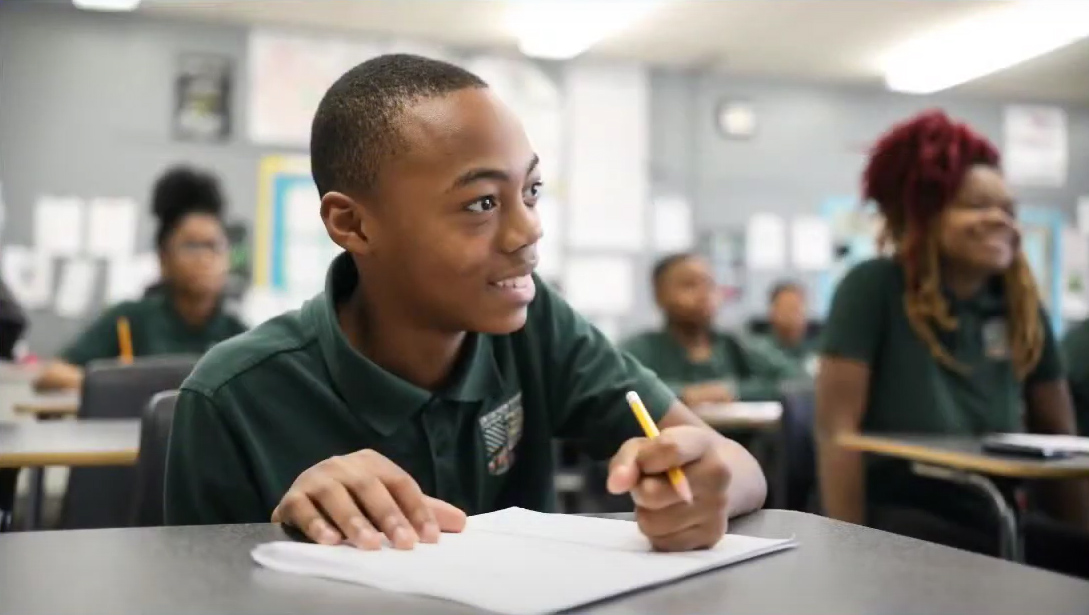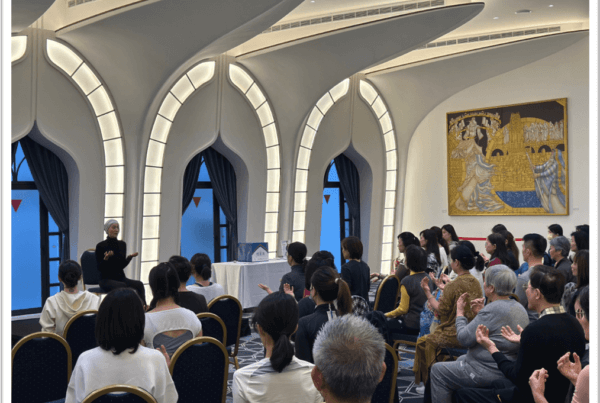In 2009, after a successful 30-year career as CEO of JoAnn Stores, a leading retailer of fabrics and crafts in the United States with over $2.3 billion in annual revenues, Alan Rosskamm was considering what he should do for his next chapter. Having accomplished his professional goals in the private sector, he wanted to explore ways he could have impact in the nonprofit realm, and in an area that he was particularly passionate about: education.
A series of exploratory visits to several public charter schools in his hometown of Cleveland led to a meeting with John Zitzner, a successful software entrepreneur who shared Alan’s passion for education. John had recently assembled a disparate group of public charter schools in the Cleveland area that focused on providing quality education to economically disadvantaged children living in urban areas. Inspired by their mission, Rosskamm joined as CEO. Working with Zitzner and the leaders of the schools, they formed Breakthrough Schools, which today is comprised of a network of 12 schools serving 3,700 children from kindergarten through 8th grade. Breakthrough Schools refers to its students as ‘scholars,’ 99% of whom are minorities and 79% of whom come from low income families.
Through the attraction of exceptional teachers, investments in technology, and proactive outreach to parents and the urban communities they live in, Breakthrough Schools quickly established a reputation for academic excellence. In 2017, a study conducted by Stanford University placed Breakthrough Schools at the top of all public charter schools in Ohio based on student performance. According to the study, “Breakthrough had students score so far ahead of traditional district schools it was as if they had taken classes for an extra 148 days, or an extra 80 percent of a school year.” Score results in reading were similar: it was as if Breakthrough students had taken an additional 120 days of school.
Outstanding student performance metrics have translated into success for many alumni of Breakthrough. Graduates have gone on to attend major colleges and universities, and have transitioned into successful careers in fields ranging from software engineering to aerospace management to movie production.
In an interview conducted via video recently, Rosskamm explains how he worked with the co-founders to establish and grow Breakthrough into Ohio’s leading network of free public charter schools; the ‘magic ingredients’ to building a successful public charter school; and how Breakthrough has continued to deliver on its mission of providing quality education since the COVID-19 crisis forced students to learn from home.
Rosskamm also explains how his Jewish values have served as a source of inspiration for the work he does at Breakthrough. His passion for pursuing initiatives aimed at achieving social equity and inclusion was inspired by the values passed on to him by his parents, Jewish immigrants who had suffered persecution and discrimination at the hands of the Nazis prior to fleeing Germany on the eve of the Holocaust. The experience of his parents, who went on to found and build JoAnn into a multi-billion-dollar company, has also motivated him to give his students at Breakthrough Schools a platform for achieving the American dream.
The following excerpts have been edited for length and clarity:
You had a long and successful career in the private sector as CEO of JoAnn. How did you decide to pivot to the nonprofit sector, and in particular, education?
I’ve always been interested in kids. We have four sons and I’ve been involved in their schools. I was a coach, not an educator. When I retired from JoAnn was looking for something to do.
I was really passionate about education and wondered if there was some way I could help urban kids have a better chance at the American dream. It’s that simple. So, I visited a couple of schools, a Catholic school on the West side, and two charter schools on the more economically challenged East side. And that’s when I met John Zitzner, who invited me to a meeting of the leaders and board representatives of three different public charter schools that were getting great academic results, but were also struggling to make ends meet.
It was at that meeting that they made the decision to formalize their informal relationship and create a shared services organization, which became Breakthrough Schools. The school leaders told me, ‘Alan, we need a business guy. We know how to educate, but we need you to help us get more sustainable and help us grow. We have so much more that we could offer.’
How did your personal values as a Jewish-American guide your decisions?
My Jewish upbringing, my heritage as the son of immigrants who escaped the Holocaust, and my Jewish values have informed my decisions throughout my career. My parents passed on the fundamental Jewish values of equal opportunity and inclusion to me and my sister. Their experience having suffered persecution for being Jewish and having fled Nazi Germany on the eve of the Holocaust left an imprint on me.
My dad’s family ran a general store in a tiny town in Germany. After the Nazis assumed power, they were harassed because they were Jewish, and were told outright by former customers that they couldn’t sell goods to non-Jews anymore. My father decided to leave Germany, and managed to find a cousin who had previously emigrated to the US to sponsor his visa. Several other family members eventually followed him out of the country. Once he arrived in the US, his first job was sweeping floors in a factory.
It’s stories like these that I heard from my parents while I was growing up that help explain why I’ve been so involved in fighting bigotry and promoting diversity over the years. I am a Life Trustee of the former National Conference of Christians and Jews, which is now called the Diversity Center of Northeast Ohio. I was a founding member and task force chair of the Commission on Economic Inclusion in Cleveland, where the CEOs of public companies came together to commit to provide more Board and senior leadership positions for minorities as well as increased job opportunities to underprivileged men and women.
In 2017 a study conducted by Stanford University placed Breakthrough Schools at the very top of all public charter schools in Ohio based on academic performance. What would you say are the ‘magic ingredients’ behind the extraordinary success of Breakthrough Schools?
When people ask, what is the ‘magic ingredient’? First of all, let me give you some demographics. Our students are 95% minority, and around 80% are receiving free or reduced price lunches, which is a measure of poverty. A high percentage of them come from single parent households. Our children come from highly disadvantaged homes. But their parents love their kids and choose our school because they want a better education for their kids.
One of the big mistakes that a lot of urban districts make is they say things like, ‘What do you expect? We’re serving the poorest children. You have to fix poverty before you can fix education.’ We believe, however, that kind of thinking is actually upside down. The only way to address poverty is to educate disadvantaged children so they can create better lives for themselves. And the key to that–and this is, I think, our ‘magic ingredient’ if we have one–is that we hold high expectations of ourselves as adults and for each of our children.
We actually believe it’s racist to lower your expectations for urban kids. To say, because they’re poor or because they’re black or LatinX that we shouldn’t ask too much of them. That is racist. And that does a tremendous disservice. What we say is these kids have tough backgrounds and a lot to overcome, but they’ve got every bit as much potential as any other child. And by having high expectations, the kids usually exceed them. And so, if there’s a ‘magic ingredient’, it is about expectations.
What kind of academic models or approaches set Breakthrough Schools apart from other public charter schools?
What makes our school successful is the culture we try and create within our schools. The miracle of our work is when a child all of a sudden believes in himself or herself. One of the key things that is increasingly important is a focus on social and emotional learning and children building self-confidence and learning to become self-advocates.
There’s also an increasing emphasis on less rote learning and more critical thinking skills, and making the education relevant for the kids. I believe that with our new central network academic team, we have the opportunity to take best practices and replicate them across our entire network, both best practices from within the organization, as well as learning from other successful school networks around the country.
Until this July, we’ve had three distinct academic models. One compelling approach is EL education, which is a national model that one of our original founders adopted. It’s based on experiential learning, where literally the community is a classroom. They’ll ask an essential question that will be their topic for an entire year. For example, ‘What makes a community thrive?’ They’ll study transportation, they’ll study why is their community a food desert with no supermarkets and no fresh produce? And then they’ll study the environment, and they’ll use that research and those studies to learn. They built a garden to grow vegetables. And then they’ll build into that curriculum the more basic learning standards that students need to master in math and literacy. A lot of the literature is around social justice and things that our students care about. We find that truly motivates students and gets them excited about their learning.
One of our other models, the Preps, has followed something called the Valor Compass, which was invented by a charter organization in Nashville. They create a curriculum about one’s personal identity and personal values. Children meet regularly with their peers in ‘community circles.’ It takes kids that might not otherwise be friends or get to know each other, and they’ll take turns preparing a personal narrative about their lives, about what they care about. This is new and it’s not fully developed. I went to Nashville and watch the Valor schools do this. It can be incredibly powerful.
This will all evolve as we develop the central academic team and it develops a more uniform point of view around the curriculum. We’ll take the best of several of those programs. But they’re all focused on building self-confidence, building voice, becoming self-advocates, and being able to tell your own story.
We also have to be very sensitive to racial inequities and the systemic obstacles that confront the communities we’re serving. So at this moment, we’ve got a major initiative around diversity, equity, and inclusion, and there all kinds of organizations in the States right now pursuing this, but we’re in it for the long haul.
We are trying to focus on our internal practices and make sure that we are truly equitable in how we hire, how we promote, how we train, with the ultimate objective of building a much more culturally sensitive and responsive school community. An important part of our equity strategy is to build meaningful and intentional partnerships with our families and the parents and caregivers that are responsible for their kids.
Kids will learn more if you’re on the same page with the adults in their lives, even if some of those parents had very bad experiences when they were in school.
How did you make the transition to remote learning when COVID-19 forced the closure of schools last year?
In March last year, our schools were closed. One of the big inequities was the fact that many of our kids did not have technology at home. And so the first thing we did was get devices and hotspots to all the kids that needed them so they could do online learning. Otherwise we would have been photocopying papers and trying to deliver them. It would have never worked. And so we went overnight into remote learning, but it was makeshift.
As we prepared for the new school year starting in August, we said, if we’re going to be remote, we’ve got to be as good as we can be because kids have to learn. Over the summer, we put in a learning management system, we put in a new online assessment system, and we put in new, more digitally-friendly curriculum. We delayed the start of school and we spent four weeks training our leaders and our teachers to do a much better job of remote learning.
I’m confident that we’ve done better than most because we took such a serious and focused approach to putting the best possible remote learning system together.
We also recognized that some of our parents could not be home with their kids. If you’re a single mom who’s working, what do you do with your ten-year-old or your six-year-old? So we created remote learning centers. We partnered with after-school providers in Cleveland, non-profit organizations that provide after-school enrichment for our kids. And obviously those people did not have work for their employees because there was no school to provide after school. We are providing in-person supervision with no more than 9 children in a classroom designed for 25-30 kids, so that the children have a safe place to be while they’re learning online.
What’s next?
After spending 30 years in the corporate world, I’ve been so blessed and fortunate to have had this opportunity for a second career. It’s really been very rewarding. I will be stepping down sometime this summer. We’re just about to launch our search, but I’m very proud of the progress we made growing the Breakthrough network in our first decade.
As we began our second decade on July 1, 2020, we were able to take three fragmented academic organizations and bring them together. We’ve got a brilliant young chief academic officer who’s built a very strong and diverse Network Academic Team. We’ve got a bunch of change management initiatives we want to get done during this year of organizational unification and COVID-driven remote learning. I tell my team that they’re in year zero of a tremendous transformation. Our job this year is to put a tremendous plan together—and then hit the ground running next year, hopefully with a robust in person return to school.







